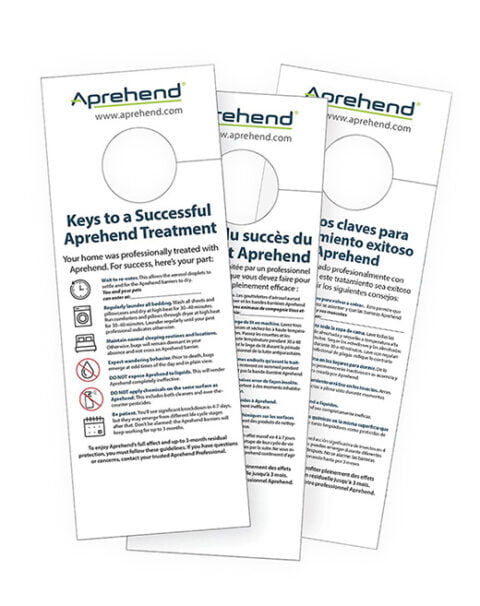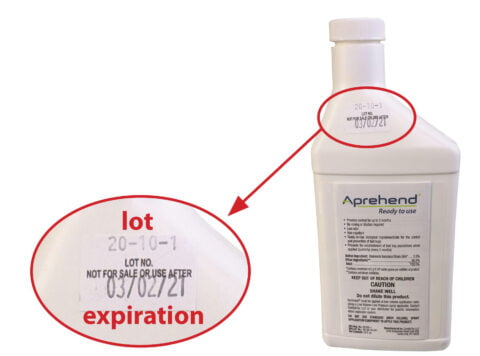Call backs are rare, but there’s always a cause and usually there’s a remedy. Let’s consider some possibilities.
Is it the client?
Did they do something they shouldn’t have? Did they return un-laundered bedding to the bed, attack the scene with DIY products, or clean off or otherwise disturb the Aprehend barriers? Is there an item that travels with the client that is infested: e.g. handbag, backpack, walking frame/wheelchair, or prosthetic? Has the client put away items that are infested (shoes, toys, electronics)? What about their vacuum cleaner? Is it a reintroduction from the original source such as a regular visitor or the client’s work environment? The Aprehend Post-Treatment Door Hanger is helpful for communicating customer do’s and don’ts (Figure 1). View them here and contact us to get yours. For more information on setting customer expectations, watch the video here.

Figure 1 Aprehend post-treatment door hangers help set customer
expectations. They’re available in English, French, and Spanish.
Is it the treatment?
Aprehend treatment is different from traditional chemical application. Make sure your Aprehend barrier placement is strategic—between the harborage and blood meal. This includes places other than the bed such as recliners, wheelchairs, home office, kitchen chairs, etc. If you’re using Aprehend in conjunction with other control methods, such as heat, steam or liquid chemicals, always ensure that surfaces are fully dry and have cooled to at least 100°F before applying the Aprehend barrier. Review information on Aprehend strategic barrier placement here and here. Discussion about complimentary products can be found here. If you’re still not sure, ring us to talk through your protocol.
Is it the Aprehend?
Aprehend has a shelf life of one year from date of manufacture. Each bottle is labeled with this info (Figure 2). Make sure it’s not expired. Also, make sure that proper storage and handling protocol has been followed. Prolonged exposure to heat will cause a decline in efficacy. See data about this here or the video here.

Figure 2 Every bottle of Aprehend is labeled with its lot number and expiration date.
Is it too soon?
Bed bug infestations take time to eradicate. Ensure you set client expectations, and schedule a follow-up to confirm eradication about 30 days after treatment. This allows time for all eggs to hatch and for recently fed bed bugs to re-emerge from their hidden harborages. Aprehend barriers remain effective for up to 3 months, so there is no need to ‘top up’ the application after 1 or 2 weeks. If follow-up inspections are done too early, you may see live activity, but this is not a failure, it takes time for all bed bugs in the population to get exposed to the fungus. However, if live activity is detected on the 30 day follow-up, then we recommend a top-up application where needed. Once you are familiar with the Aprehend application strategy, you will find this to be very rare. Remember, vacuuming of visible bed bugs during the first service provides the fastest “knockdown” and relief for the client, ensures clean surfaces for application of Aprehend, and facilitates your follow-up inspection.
Is it for real?
Delusional parasitosis is a rare but real psychiatric condition in which a person believes they are infested by parasites even though they are not. You can offer monitors to collect evidence if the client is unable or unwilling to accept that the infestation is eradicated. If any bed bugs are caught in the monitors, conduct a follow-up treatment as necessary. You can also check for the presence of Aprehend with these bed bugs by performing the Ziploc bag test to accelerate and exaggerate Aprehend sporulation (instructions here). This will indicate if the Aprehend barriers were still working. If the bed bugs do not show fungal infection, it is possible that the barriers in that area were removed or damaged in some way.
Still stumped?
Contact us. We’ll walk through the situation together and come up with a course of action. We’re here to help.

